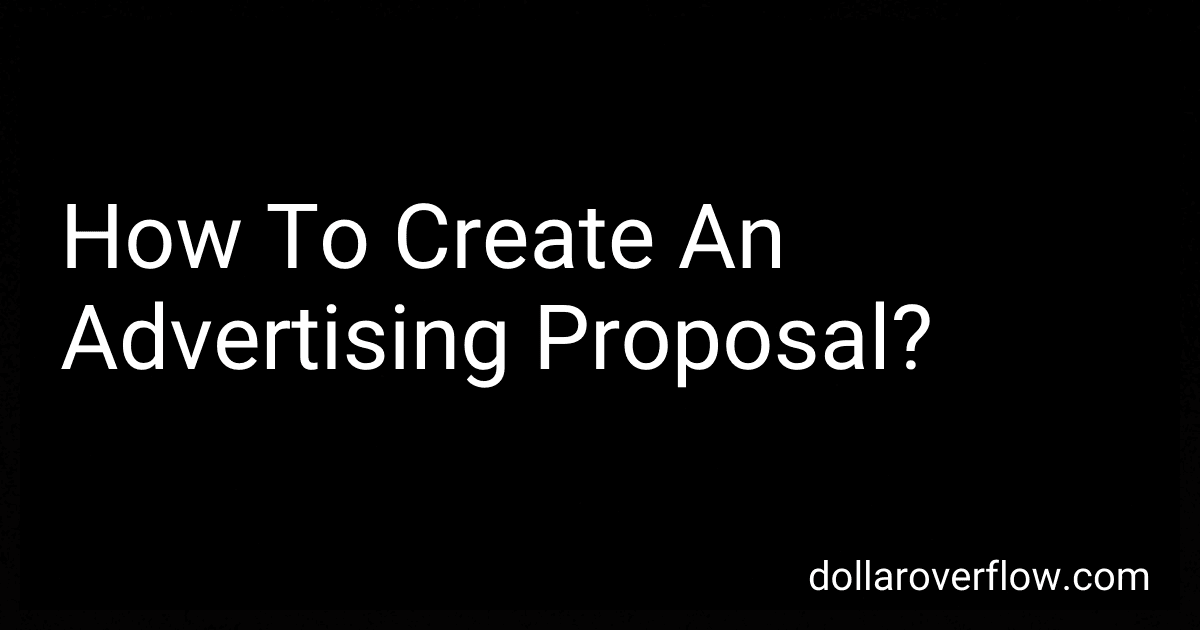Creating an advertising proposal is an essential part of the advertising process, as it outlines the details of a potential advertising campaign and helps to sell the idea to clients or stakeholders. To create an effective advertising proposal, start by researching the client's business and target audience. Understand their goals, challenges, and competitors, and use this information to tailor your proposal to their specific needs.
Next, outline your proposed advertising strategy, including the objectives of the campaign, target audience, messaging, and creative concepts. Be sure to explain how your approach will help the client achieve their goals and stand out from the competition. Include details on the different advertising channels you plan to utilize, such as print, digital, social media, or television, and explain why these channels are the best fit for the client's needs.
Include a detailed budget breakdown, outlining the costs associated with each aspect of the campaign, such as creative development, media placement, production, and reporting. Be clear and transparent about your pricing, and explain how each expense contributes to the success of the campaign.
Lastly, include information about your agency's experience and credentials, highlighting any relevant case studies or success stories. Show the client why they should choose you over your competitors, and demonstrate your expertise in delivering effective advertising campaigns.
By following these steps and presenting your proposal in a clear, professional manner, you can increase your chances of winning new business and building successful advertising partnerships.
How to follow up with a client after submitting an advertising proposal?
- Send a thank you email: Start by thanking the client for considering your proposal and expressing your enthusiasm about potentially working together.
- Provide additional information: If there were any details or questions that came up during the proposal review process, be sure to address them in your follow-up communication.
- Request feedback: Ask the client for feedback on the proposal and if there are any changes or adjustments they would like to see.
- Schedule a follow-up meeting: If appropriate, suggest scheduling a follow-up meeting or call to further discuss the proposal and address any questions or concerns the client may have.
- Stay top of mind: Continue to stay in touch with the client by sharing relevant industry news, case studies, or updates on your company's work to keep the conversation going.
- Be patient: Give the client some time to review and consider your proposal before following up. Avoid being too pushy or aggressive in your follow-up communication.
- Follow up periodically: If you don't hear back from the client after your initial follow-up, it's okay to send a polite reminder email or make a phone call to check in on the status of the proposal. Just be sure to respect their time and decision-making process.
What should be included in an advertising proposal?
- Introduction: A brief introduction to your company and its services, as well as an overview of the advertising proposal.
- Objectives: Clearly define the goals and objectives of the advertising campaign, including target audience, key messaging, and desired outcomes.
- Strategy: Outline your proposed advertising strategy, including the channels and platforms you plan to use, the creative concepts and messaging, and the timeline for implementation.
- Budget: Detail the budget for the advertising campaign, including a breakdown of costs for each component of the campaign.
- Deliverables: Specify the deliverables that will be provided, such as ad creative, media plans, and reporting metrics.
- Timeline: Provide a timeline for the advertising campaign, including key milestones and deadlines.
- Team: Introduce the team members who will be working on the campaign, including their roles and expertise.
- Case studies/Testimonials: Include case studies or testimonials from previous clients to showcase your experience and success in advertising.
- Terms and Conditions: Outline the terms and conditions of the proposal, including payment terms, cancellation policies, and confidentiality agreements.
- Call to action: End the proposal with a clear call to action, inviting the client to move forward with the advertising campaign.
What should the tone of an advertising proposal be?
The tone of an advertising proposal should be professional, persuasive, and enthusiastic. It should convey confidence in the proposed strategy and showcase the benefits of the advertising campaign. The language should be clear, concise, and engaging to capture the attention of the client and convince them of the value of the proposed services. Additionally, the tone should be positive and proactive, demonstrating a readiness to collaborate and deliver results for the client.
